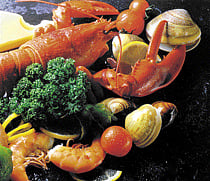

India has 2,500 miles of coastline and over 2,000 varieties of fish, so it is no wonder that seafood is immensely popular here. Steamed, fried or curried, seafood tastes best when cooked just after it is freshly brought. The style of cooking seafood differs all along the coastline. There is a saying on seafood which goes, ‘In European cuisine, the fish flavours the dish, while in Indian cuisine the dish flavours the fish’.
In this feature, I will restrict myself to west coast from Goa to Kerala with an emphasis on Manglorean cuisine of Karnataka. Molluscs and crustaceans including mussels, scallops, cockles, clams, oysters, crabs, lobsters, prawns, snails and squid, are delicacies here.
Green mussels are quite popular in the coastal city of Mangalore, where they are known as pachile in Tulu. Pachile sukka, pachile curry, pachile aajadina and pachile combined with drumsticks or other vegetables or filled with rice, spice and coconut are popular in homes and the odd restaurant. In fine dining restaurants you will find marinated mussels, mussel soup, mussel pasta salad, mussels and spaghetti, mussels in white wine, mussels in mustard sauce, mussels with leeks, saffron and cream and so on. Try one popular and traditional Mangalorean recipe:
Kaithina Pachile
Ingredients: Mussels; Turmeric powder to taste; Water; Refined oil; 2 tsp lime juice; 1 tsp garlic paste; 1 tsp ginger paste; 1/2 tsp salt; 2 eggs, 1/2 tsp red chilli powder; 1/2 tsp garam masala; a handful of semolina spread on a plate to coat the mussels.
Method: Boil mussels in water with turmeric powder for 4 to 5 minutes. Strain the water and remove the mussel meat from the shell. In a bowl add mussels, lime juice, garlic paste, ginger paste, salt, egg, red chilli powder and garam masala. Mix it well. Now coat mussels with semolina and deep fry them till done. Kaithina paichile is ready to eat. Serve hot with green chutney.
Scallops
You can try the same recipe with scallops or clams, which are edible bivalves similar to oysters. Scallops are found both in bay waters and in the sea. They do not attach themselves to a permanent anchorage, but move through the water by opening and closing their shells. As a result, the muscle that controls the ‘hinge’ of the shell is much larger than that of oysters or clams.
The term ‘clam’ can be applied to freshwater mussels, and other freshwater bivalves, as well as marine bivalves. Clams are bivalves which burrow in sediment. In the south western coast of India, also known as the Konkan region, clams are used in curries and side dishes.
Oyster is used as a common name for a number of distinct groups of bivalve molluscs which live in marine or brackish habitats. The valves are highly calcified. Some kinds of oyster are commonly consumed by humans, cooked or raw. Unlike other molluscs, the edible variety of oysters are not easily available.
Cockles
Cockles is the common name for a group of (mostly) small, edible, saltwater clams. Various species of cockles live in sandy, sheltered beaches throughout the world. The distinctive rounded shells of cockles are symmetrical, and are heart-shaped when viewed from the end. In most but not all general there are numerous radial ribs. Cockles, which are known as marwai in Tulu, are popular in Mangalore. Marwai sukka is a popular recipe in Mangalore and serves as a tasty accompaniment to rice. This is not something which you can find easily in restaurant. However, I was once surprised to find marwai sukka in a restaurant called ‘Fishland’ in Hubli.
Another popular dish, which is a complete meal by itself is cockles with rice dumplings called Pundi Marwai in Tulu and Kube Mutli in Konkani. Don’t ask for it is restaurants. Try this recipe:
Pundi Marwai/ Kube Mutli
Clean around 100 cockles and keep aside.
Ingredients/Method (for dumplings): Boiled Rice — 1 kg; Salt — to taste. Wash and soak the rice for 2-3 hours. Strain the water, grind it fine with salt to taste. Dough should be pliable, not watery. Make small dumplings and steam for about half an hour.
Ingredients for the masala: Dry chillies — 12; Pepper corns — 8; Coriander seeds — 2 tsp; Jeera — 1 tsp; Mustard — 1 tsp; Turmeric; Garlic — 6 flakes; Onion— 2; Tamarind — small lemon-sized ball; Coconut — 1 full; Coconut milk (both thick and thin); Salt to taste.
Method: Roast chillies, onion, coriander and coconut separately. Grind all the masala including roasted coconut with thin milk. Heat oil and fry onions. Add masala and water. When boiled well, put in the rice dumplings and after 5 minutes and cockles. Add thick coconut milk.
Squid
Many species of squid are popular as food in cuisines as diverse as Chinese, Greek, Turkish, Japanese, Italian, Spanish, Korean and Indian. In English-speaking countries, squid as food is often marketed using the Italian word calamari.
Squid are found abundantly in certain areas. They can be stuffed whole, cut into flat pieces or sliced into rings. Squid is a food high in selenium, vitamin B12, and riboflavin.
Bondas (Squid) chilli fry
Ingredients: 1/2 kg squid cleaned; 1/4 kg chopped shimla mirchi; 1/4 kg tomatoes; 1 tsp jeera; 1 tsp mustard; 2 tsp urad dal; 8 to 10 green chillies; Ginger-garlic paste 1/2 cup; Oil and salt to taste; Curry leaves; Coriander leaves chopped; 1 lemon.
Method: In a pressure cooker heat 8 to 10 tsp cooking oil. Add 1 tsp jeera, 1 tsp mustard seeds, 2 tsp urad dal, curry leaves, 1 tsp ginger and garlic paste, 8 to 10 green chillies paste. Now add shimla mirchi (green) cut in to long strips, chopped tomatoes and cleaned squid.
Mix and fry with masala for 10 to 15 minutes. Garnish with chopped coriander leaves and lemon juice. Serve hot with steamed rice or rotti.
